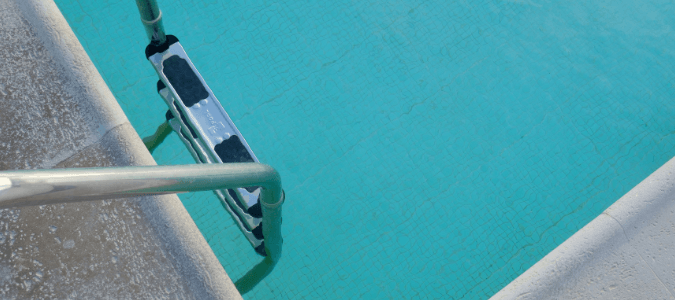
Closing your pool for the season? Why would you? Sure, the weather gets colder in the south over the winter, but it’s not freezing like in northern states. Even if you don’t plan on really using your pool, “closing” it seems like a lot of unnecessary work.
That’s what you thought—until last year.
This past winter, you neglected your pool in the off-season, and in the spring you paid for it—literally. Your backyard oasis sustained damage and cleaning that needed to be addressed before you could swim again.
You don’t want that to happen again this year, but you’re not quite sure exactly how to winterize your pool.
In this post, we’ll share expert advice with you on closing a pool for the season so you can dive in when the temperatures heat up again.
Why Maintain Your Pool During Winter?
Before we go into more detail about what pool owners need to do during the swimming offseason (which can, admittedly, be quite short in warmer climates), let’s answer the most basic question about why you even need to care for your pool in the winter. Simply put, proper pool maintenance is vital during the cooler months of the year because it:
- Preserves the quality of water in your swimming pool.
- Secures and preserves swimming pool equipment and accessories.
- Protects and preserves your pool surfaces.
When a pool isn’t taken care of as it should be during winter, various problems are bound to occur. A few examples of headaches pool owners may experience come springtime can include:
- Freeze-damaged pool tiles;
- Broken swimming pool pumps, chlorinators and other equipment and
- Algae overgrowth.
While winter pool maintenance is easy and fairly cheap, failing to do it properly may result in frustrating and costly repairs when you return from your pool maintenance vacation.
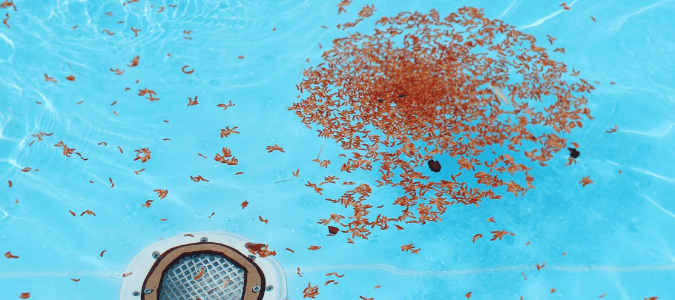
Winter Pool Maintenance
Winter pool maintenance in southern states differs a bit from what is typically considered “winterization” in the north. Despite this, there are a few similarities. Across the country, your goals are the same, as we have already stated: to prevent equipment and parts damage, to preserve your water quality and to protect your pool surface.
Pool experts recommend you thoroughly clean your pool, safeguard sensitive components, store your accessories and cover your pool if you won’t be swimming for an extended period of time.
Cleaning Your Pool
A pool should be cleaned thoroughly before you close it for the winter. Cleaning should involve thorough brushing of all swimming pool surfaces, such as coves, walls and the floor. Leaves, dirt and all other floating debris must also be removed. An experienced pool technician will also typically recommend that you vacuum- or power-wash your pool before you shut it down for the colder months of the year.
Protect Swimming Pool Equipment
As we all know, water begins freezing at 32 degrees Fahrenheit. Microscopic ice crystals start forming at around 30 degrees. As this process takes place, your pool water volume increases by about 9%. The expansion results in pressure build-up of as much as 114,000 psi. Such pressure is enough to burst swimming pool pipes, crack pool tiles and disrupt the concrete used to build the swimming pool.
We may not get many weeks of these kinds of temperatures here in the south, but there are still times almost every year where the temperatures drop at least close to this level—and sometimes below that.
Unless you have high confidence that you are in an area where the temperature will not get this low, you should do the following to protect your pool equipment:
- Remove all accessories, such as pool ladders, motors, pumps and diving boards. This equipment should then be stored in a dry, sheltered place.
- Completely drain water from all pool pipes, filters, chlorinators, pumps, heaters and so on.
What specifically should you do to your other equipment? Read on to find out.
Pool Pump And Filter Care
Your filters and pool pump need some specialized care when temperatures drop. Follow these preventative maintenance steps to avoid any problems when you have a spell of frigid temperatures:
- After turning off the pump switch, waterproof the terminal box.
- Open all pump valves and remove the drain plug from the pump.
- Completely drain the filter tank. Your filter elements and filter covers should be removed, cleaned and stored in a dry place, free from dirt and dust.
- Use waterproof coverings to protect outdoor pumps. Alternatively, outdoor pumps should be disconnected and moved into a dry, safe room.
- Miscellaneous pump fittings and drain plugs that have been disconnected should be stored in a pump (hair and lint) basket.
What’s next? Your pool chlorinators and chemical feeders.
Care Of Pool Chlorinators And Chemical Feeders
These pool components can be fully protected from freezing temperatures if a pool does the following:
- Disconnect power to the chlorinator and chemical feeders.
- Drain water from all the parts of the chlorinator/chemical feeder.
- Remove outdoor chlorinators/chemical feeders and store them in a dry, safe room.
- Return chlorine gas cylinders to the supplier when your swimming pool closes.
- Remove cells within electrolytic chlorinators. After water has been drained off completely, the cells should then be stored in a safe, dry place.
- Clean calcium carbonate/calcium hydroxide deposits off hypo-chlorinator systems and drain water from hoses and the hypo-chlorinator diaphragm. The integrity of the hypo-chlorinator system should then be checked. The system’s electric motor should be removed and stored away in a dry, warm location.
You’re halfway there! Now onto your pool heater and lights.
Heaters And Light Care
Safeguard your lights and heater by following these guidelines:
- UV generators should be drained. The lamp and quartz sleeves should be removed and stored in a warm, dry area.
- Drain your pool’s heater equipment. At the same time, turn off the pilot flame and main gas valves, as well as the pool’s gas supply.
- Clean the heater tubes.
- Remove and disable the pool lights form all niches and store them away in a dry, warm place after completely purging them off any water present.
Last, but certainly not least, it’s time to check out your skimmers.
Care Of Pool Skimmer
When temperatures outside get low for a sustained period, drain all your skimmers. Use rubber plugs to prevent entry of snow or rainwater. Put antifreeze into each skimmer.
Almost all of the tasks we’ve covered above must be carried out in line with the instructions set out by the manufacturer of the pool equipment. Perfect execution of these tasks requires some level of expertise.
Store Accessories
Chances are good if you have a pool that you also have some accessories you use with it. Floats. Skimmers. Toys. The list goes on.
Leave these out over the winter and you’re likely to come back to equipment that has been destroyed or made disgusting by weather and various critters that stop by over the colder months.
To prevent yourself from having to replace everything each year, you need a place to safely store it, and you need to clean and (if necessary) deflate items before putting them away. This will increase the likelihood that you can use these accessories again next year.
Cover Your Pool
If you don’t intend to use your pool for a month or longer, the final step when winterizing a swimming pool involves covering the surface with a secure, undamaged and clean pool cover. There are different types of winterizing covers. Therefore, it’s best that you ask a pool expert which cover is best suited for your pool. Additionally, pool pros can help ensure your cover is the correct size.
Leaves and other forms of debris that fall on the pool cover must still be removed periodically to prevent damage to the pool cover, and the cover must be monitored regularly to avoid any accumulation of snow, ice, or (more likely for most pool owners in warmer climates) water on its surface.
Some procedures, such as draining water from your pool pumps and heater, are best performed with specialized equipment such as low-pressure compressors and a wet/dry shop vacuum. For those reasons, many pool owners outsource winterization to trained pool professionals.
What if you intend to keep your pool open during the winter?
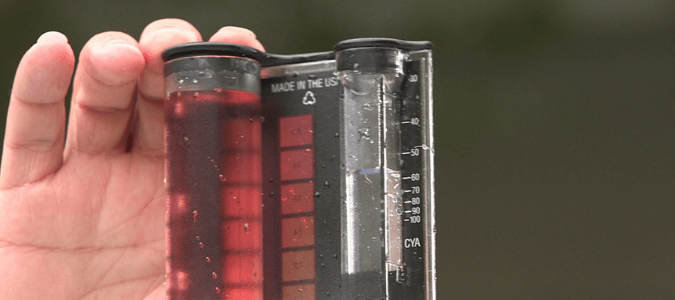
What Chemicals Do You Put In A Pool For Winter?
Preserving the quality of water in a swimming pool involves balancing the water’s pH, hardness and alkalinity, along with other chemicals. As temperatures drop, water becomes more corrosive as a result of a declining Langelier Saturation Index. Restoring the water balance is thus a preventive measure against destruction and staining of the pool’s interior finishes.
Besides balancing, other water issues should be identified and resolved if you decide to close your pool during the cooler months. Such problems, if left unchecked, may fester throughout winter and present as a huge, complicated problem once a pool is reopened. Different chemicals are used to take care of different water problems during winter.
What winter pool chemicals do you need to pay attention to?
Algaestats And Algaecides
Algaestats are chemicals that inhibit algae growth. Algaecides are chemicals that kill algae. Those two types of chemicals should be used to control algae growth during winter.
Why?
Because even with a pool cover present, fine organic debris and sunlight may get into the pool, encouraging the growth and proliferation of algae. It’s thus prudent to apply algaecides and algaestats before closing the pool, in the middle of winter, and about a month before opening the pool again.
Chlorine
Chlorine complements the activities of algicide and algaestats, and should be applied concurrently with each algaestat/algaecide application.
Winterizing Agents
Some of the best winterizing products are multipurpose pool maintenance agents that clean and balance the pool water while simultaneously preventing the growth of algae and other microorganisms during winter.
Chemicals That Correct Your Pool’s Saturation Index
The saturation index of your pool water is a measure of the interaction of the pH, calcium levels, alkalinity, dissolved solids and water temperature (i.e., the Langelier Saturation Index). A positive Langelier Saturation Index results in scale deposition, while a negative index leads to corrosion within the pool and its equipment. Rock salt (calcium chloride dihydrate) and bicarbonate can be added to correct the alkalinity of the pool water, thereby restoring the proper saturation index.
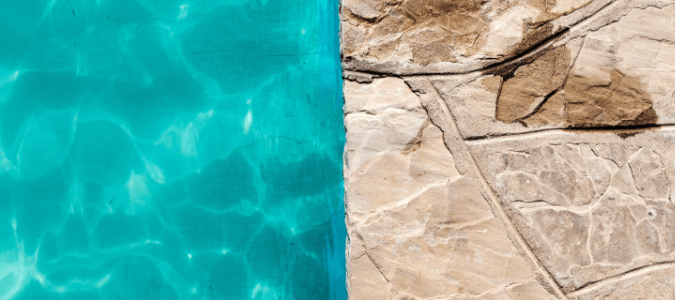
How Far Down Do You Drain Your Pool For Winter?
Depending on how cold it gets in your area, your pool may not need to be extensively drained.
If there is a chance of freezing, enough water should be removed such that the remaining water level is below the pool’s skimmer. This prevents freeze damage from occurring in the pool lines when water expands during freezing. Subsequently, water must also be drained out of the pool lines and/or a non-toxic, pool-friendly antifreeze added.
Most experts do not recommend the complete draining of in-ground pools. This is because groundwater around the pool may exert hydrostatic pressure against the pool structure. When this happens, cracks may develop and, in some instances, the pool may be pushed out of the ground. Vinyl-lined pools often wrinkle after complete drainage of their water.
If you are not worried about freezing, you should still drain your pool slightly in preparation for any rain or snow that may fall. Basically, you want to drain enough water out so that the pool doesn’t overflow due to precipitation.
Most pool professionals agree that retaining more water in a pool during winter translates to better protection of the liners, plaster, and other pool finishes from damage caused by prolonged exposure to the atmosphere. Nevertheless, the water level shouldn’t rise beyond the pool’s tile line.
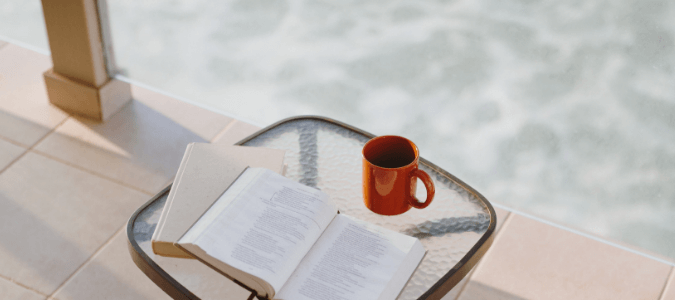
How To Winterize A Saltwater Pool
Closing down a saltwater pool for the season is a bit different than a traditional pool. Commercial winterizing kits have been developed to make this task easier for pool owners. These winterizing kits contain agents that sequester or chelate certain elements that may be dissolved in the pool water. Since each winterizing kit comes with manufacturer’s guidelines, it’s essential that you stick to the recommended instructions of use.
Generally speaking, though, these are the steps you should follow:
- Clean your pool, making sure to vacuum it.
- Check the pH and alkalinity and adjust as necessary.
- Add the correct saltwater-compatible winterization kit, following instructions closely.
- Run your filter for an hour or more.
- Add a winterizing plate to your skimmer.
ABC Can Care For Your Pool All Year Long
As you can tell, your responsibilities in winterizing your pool vary for a number of reasons. If you’re not quite sure how to proceed—or just don’t feel like you have the time or effort to devote to it—the best thing to do is reach out to a professional. The pool pros at ABC Home & Commercial Services have been doing this for generations, and we understand what’s appropriate for your respective area. We can take care of your pool in winter so that it’s ready to go once you are ready for your first swim of the season.
